
Worldcarblog.com
Now and definitely: the EU has banned the sale of new gasoline and diesel cars from 2035.
The European Parliament on Tuesday gave final approval to the mandatory implementation of zero emission rates for new cars and vans from 2035, meaning that in 12 years no new petrol and diesel cars will be sold.
The new CO2 emission standards for cars and vans are part of the "Ready for 55" legislative package, and the decision was supported by 340 votes in favour, 279 against and 21 abstentions.
The regulation was supported by representatives of social democrats, greens and liberals in the European Parliament.
"This regulation encourages the production of zero-emission and low-emission vehicles. These goals provide clarity to the automotive industry and encourage car manufacturers to innovate and invest. It will be more affordable for consumers to buy and use zero-emission vehicles, and the used vehicle market will develop faster. In this way, sustainable transport will become available to everyone," said Liberal Club rapporteur Jan Huitema (Renew).
Tp means that in 12 years it will no longer be possible to sell new cars with diesel and gasoline engines, but only new vehicles without harmful emissions. The transitional targets for reducing harmful emissions for 2030 are 55 percent for cars and 50 percent for light commercial vehicles.
In practice, this means that new cars and vans on the market will no longer be allowed to emit CO2, but cars with internal combustion engines will not disappear from the roads.
Even after 2035, citizens will still be able to drive their existing cars with internal combustion engines, and even buy used gasoline and diesel cars.
After the final vote at the plenary session of the European Parliament, the text still needs to be formally approved by the Council before being published in the Official Journal of the EU.
2024 Toyota bZ3X
At first, Toyota’s bZ4X electric SUV had us scratching our heads. Was this a nameplate left scrambled? An unsolved CAPTCHA? However, after Toyota teased a larger bZ5X SUV, and later this compact bZ3X crossover, the nomenclature makes a little more sense. As another offering in Toyota’s growing bZ (Beyond Zero) model lineup, the bZ3X exists today as a concept, but will eventually fill a C-HR-sized hole in the upcoming bevy of Toyota EVs. Powertrain details including battery size and maximum driving range are still closely guarded, but the bZ3X is an obvious entry into the subcompact crossover segment of the future. This a necessary step in Toyota and Lexus’s plan of 30 new EVs by 2030.
What's New for 2024?
It’s early yet, and Toyota is keeping hush on details about the bZ3X, but we think this almost-production-ready concept could be ready for ordering sometime in 2023.
We’ll have to wait until Toyota spills the beans on powertrain details and equipment offerings before we can suggest a specific bZ3X, but it’s likely Toyota would give its most compact electric SUV the option of single front-motor or fully loaded dual-motor powertrains. That’s something to keep the starting price somewhat admirable as a base model, and likely a higher-horsepower and longer-range top-tier offering.
As more information becomes available, we'll update this story with more details about:
EV Motor, Power, and Performance
Range, Charging, and Battery Life
Fuel Economy and Real-World MPGe
Interior, Comfort, and Cargo
Infotainment and Connectivity
Safety and Driver-Assistance Features
Warranty and Maintenance Coverage
Kia is discontinuing production of its most beautiful model
The Korean manufacturer is withdrawing its most prestigious model from the offer until recently.
Kia Stinger, one of the most attractive cars in its class and certainly the most interesting Kia in this millennium, is going down in history. This spinner will be replaced by a new one - you guessed it - the Stinger will be replaced by the electric EV6, especially in the GT edition.
The Stinger was introduced in 2017, and immediately stood out with its extremely attractive appearance, but also with a high dose of luxury.
V6 engines dominated, a 4×4 version was also offered, and a diesel engine arrived later. The model was redesigned in 2020, but this did not significantly affect its popularity.
Now the model is saying goodbye with a celebratory Tribute Edition, available in 1,000 copies, index.hr writes. The car is distinguished by a special color of the exterior, as well as a slightly different decoration in the cabin.
Of course, there is also a plate with the designation of the special series. When it comes to the engine, the offer is reserved exclusively for the 3.3 V6 T-GDI twin-turbo with 370 hp and 510 Nm. The price is not known.
2025 Buick Electra E5
Buick’s electric future will wear a name from its gas-guzzling past: Electra. The first of the Buick Electra lineup will be the 2024 Electra E5 SUV, which will also be sold in China. Powered by General Motors’s Ultium battery platform, the Electra E5 should deliver similar performance and driving range as the Cadillac Lyriq. That should mean around 340 horsepower and around 300 miles of driving range per charge. We haven’t seen any pictures of the Electra E5’s interior yet, but we’re expecting that it will contain about the same amount of space as the gasoline-powered Envision SUV.
What's New for 2025?
The Electra E5 will be Buick’s first electric offering when it goes on sale in late 2024. We know that it will be produced in China for the Chinese domestic market, but it’s unclear if the North American version will be produced here or imported from Asia.
If the Electra follows the Buick brand's current trim structure—and that's an open question at this point—the base model will likely be the Preferred trim, with a mid-range Essence adding more luxury features, and a range-topping Avenir carrying the most goodies and the biggest price tag. When we find out more about the Electra E5 and its standard and optional equipment, we'll update this story with that information.
As more information becomes available, we'll update this story with more details about:
EV Motor, Power, and Performance
Range, Charging, and Battery Life
Fuel Economy and Real-World MPGe
Interior, Comfort, and Cargo
Infotainment and Connectivity
Safety and Driver-Assistance Features
Warranty and Maintenance Coverage
Tesla and Lexus – the safest cars
Car safety has largely been an area where Mercedes-Benz and Volvo have ruled.
The German Auto Club (ADAC) analyzed the statistics from Euro NCAP crash tests and active safety system tests and concluded that the situation is changing dramatically.
- In 2022, Mercedes and Volvo will not share the winning podium for the safest cars, but two models from Tesla and Lexus - it was announced.
Tesla's strategy of collecting a large amount of real accident data appears to be working. It is not only the transition to electromobility and the onslaught of new brands that is currently putting pressure on established premium manufacturers, but also the high adaptability of the competition when it comes to safety. This applies especially to the newcomers from China, who probably learned from earlier mistakes, made a big step forward, and now some have deservedly found themselves among the top ten, HAK Review points out.
Mercedes is still represented on the list of the best, while e.g. BMW failed to make the top ten with the 2 Series Coupe. That's why there is the Chinese Way Coffee 01, and the Chinese-Mercedes co-production Samrt #3. In eighth place is another Chinese car, the Nio ET7.
These are the ten best crash test models according to the Euro NCAP standard, which were tested this year:
Car model Body type Rating
1. Tesla Model S hatchback 92.4 percent
2. Tesla Model Y SUV 92.2 percent
3. Lexus RX SUV 89.4 percent
4. Mercedes EQE notchback 89.0 percent
5. Wey Coffee 01 SUV 88.4 percent
6. Wey Coffee 02 SUV 88.2 percent
7. Smart #1 SUV 88.0 percent
8. Mercedes-Benz C-Class Notchback, wagon 87.4 percent
8. Hyundai Ioniq 6 hatchback 87.4 percent
8. Nio ET7 notchback 87.4 percent
First drive: Toyota Corolla Cross
The best-selling car of all time now has a brother: although younger, the new member of the family is bigger, more powerful, and more advanced.
What did we have? So, in the past couple of years, Toyota has rounded out the cross section of its smaller cars.
In order: the urban Aygo received a version transformed into a new model with the X mark (although it is clearly a cross philosophy), then the (inter)urban Yaris experienced a transformation of character and name, getting a bigger brother also with the cross mark, and this fall the legendary Corolla became a dual personality – the Corolla Cross appeared.
The new issue of Auto magazine is on sale, read the driving impressions of the latest car models.
Although the (relatively speaking) basic models became bigger over time, it was not until the family of cross versions gave them dimensions that practically took them half a class higher in terms of dimensions, as is the case with the newly arrived Corolla Cross, which almost equaled its dimensions with the previous generation of the RAV4 model.
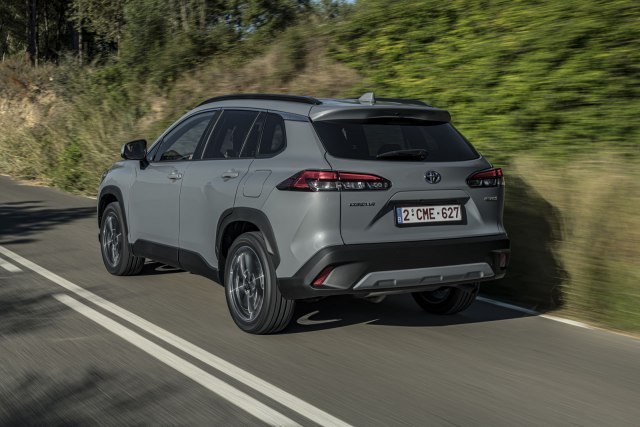
It's hard to precisely categorize the Corolla Cross. Although Toyota classifies it in the SUV category of the C segment, we would rather say that, primarily in terms of its capabilities, this is a "light" SUV car.
Compared to the standard Corolla, the Cross has grown in all three directions, it looks serious, it seems convincing and in its essence it differs from the model from which it is an offshoot.
It was created on the proven GA-C platform, so upgrades and improvements were relatively simple, and the application of new technological solutions was easy.
What explains the breakthrough in a few sentences is the hybrid technology of the fifth generation, the improvement of driving, the application of all advanced multimedia solutions, and, last but not least, the comprehensive systems of active and passive safety.
If we add to that the Japanese commitment to reducing consumption and pollution, then we have before us a technically modern work that rightly bears the family name Corolla, created a little more than 55 years ago.
From the outside, Corolla Cross is unmistakably recognizable as a Toyota - it's trapezoidal forms of headlights, front grills, the lower part of the bumper, along with the same lines of elements on the rear part.
Even the side protective panels follow that design idea. The main lights (in all equipment packages) have bi-led technology. The car is 4.46 m long, and in terms of dimensions it is placed between the C-HR and RAV4 models.
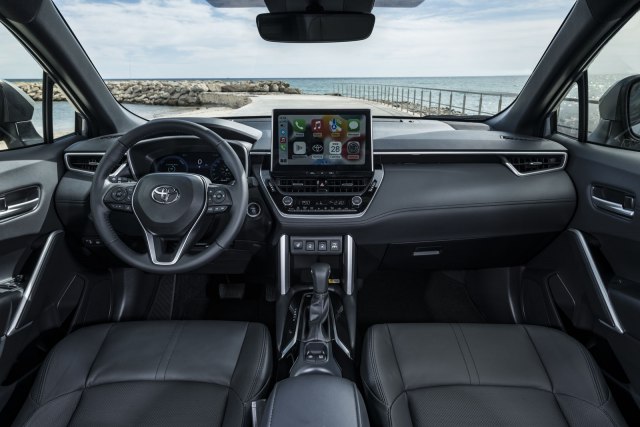
In order for everything to be nicely rounded (not to say bumpy), there are several options of alloy wheels, diameter 17 and 18 inches, in several shades and several combinations of appearance and number of spokes.
The new model is intended for family people, who need comfort, space for children, but also enough space for things in the trunk.
The volume of the luggage compartment is 433 liters, and by folding down the backrests of the rear seats, you get 900 liters of additional space.
The heart of the technology is the latest, fifth generation hybrid system. It is about self-rechargeable battery technology, created 25 years ago.
With each improvement, hybrids become better, bringing more power, with less consumption and gas emissions.
It is a completely new hybrid lithium-ion battery: in addition, it is smaller and lighter, with a capacity that is higher by 14 percent.
As for the gasoline engines themselves, there are two on offer - 1.8 and 2.0 liters, which are installed in front-wheel drive versions, and the possibility of intelligent all-wheel drive (AWD) is provided only with a stronger unit.
However, for now, only the version with a two-liter engine is ready for delivery, while cars with a smaller capacity engine are expected soon, probably in the spring.
Until it hits the roads, just a few basic data about the performance of the stronger engine: its exact displacement is 1987 cc, and the maximum power (combined with the electric motor) is 197 hp, and a maximum acceleration of about 7.5 seconds to 100 km/h .
An important item of this car is the planned smart all-wheel drive option.
Although the Corolla Cross is not an example of a classic all-terrain car, the ability to distribute transmission to the front and rear wheels will come in handy in situations where you lose good contact with the ground, when turning or accelerating.
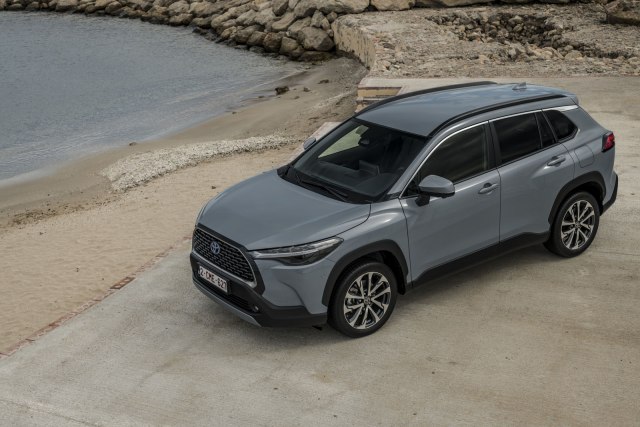
In normal driving modes, power is transmitted only to the front axle, thus reducing consumption.
And, if there is a protective sign Toyota, then it's safety and an almost endless list of systems that protect the driver and passengers.
The starting point is Toyota's technology called T-Mate, which includes protection against almost all risks, from warning of the possibility of a collision, driving assistance, detecting pedestrians or cyclists, obstacles on the road, all the way to assistance when parking or unparking, or navigation in real time.
Meeting the Corolla Cross in person is a surprise, not just because of the car's size, but the character it displays. The car looks strong, but also elegant, large as well as harmonious.
Its height facilitates access from all sides, entry into the cabin is easy and practical, Inside, comfortable seats, steering wheel with optimal dimensions in diameter and circumference.
The digital instrument panel (12.3 inches) dominates in front of the driver, the display of which can be set in countless ways, whether it is the data you want in front of your eyes, or the color.
Even more dominant is the large screen of the multimedia system, with a diagonal of 10.5 inches. Should I say it works faster, better, more…
The Corolla Cross is confident on the road. Quiet, with a quick response on the gas pedal, with smooth acceleration that seamlessly picks up speed, assuring you that the power you need will always be available. And the braking is even, calm, even at higher speeds it won't push you out of the seat.
In a word, comfort is guaranteed, both for the driver and for the passengers, both in the front and in the back. There is more than enough space, and there will be no shortage of entertainment.
Multimedia with connection possibilities via applications, music, wireless mobile phone charger, automatic air conditioning or USB ports...
With the introduction of the Corolla Cross to the range, Toyota has rounded out its range of practical SUVs.
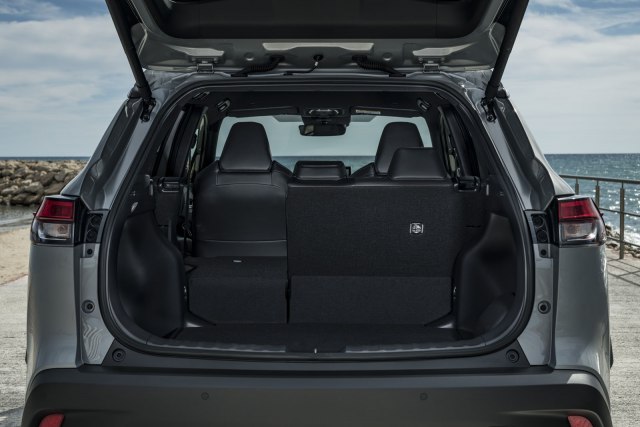
The new model has already arrived in Serbia, we are expecting it soon for a test drive, which will be an opportunity to get to know the model in more detail, which promises good moments behind the wheel, but also the obligation to fulfill the high criteria that buyers of the Japanese brand are used to.
Help
Corolla Cross is equipped with innovative solutions from the T-Mate package for driving and parking assistance: these are advanced parking functions, blind spot control, assistance for safe exit of the vehicle and a reminder of things or people in the back seats.
We list just a few functions that can give confidence to the driver, making driving and parking safer for you, but also for other road users.
Spatial Planning
A convenient load height and boot space mean you'll have room for everything from transporting the kids to enjoying the weekends.
Want more space? No problem! The 60/40 split folding rear seats instantly provide space for suitcases, bikes and anything else you need to take on the road.
Practical space for small items, including a cassette in front of the passenger and a holder for six cups, guarantee that you will have room for everything and everyone.
MyToyota application
When you're busy or driving, the MyT smartphone app provides an intelligent connection between your smartphone and your car, MyT does everything from planning your journey home, to sending you updates and service notifications.
The Hybrid Coaching feature analyzes your driving and tells you how you can improve fuel efficiency on the road.
Toyota Hilux powered by hydrogen
Driven by growing customer demand and Toyota's humane approach to mobility in all sectors, the company recognized a new opportunity in the commercial vehicle market to offer zero-emission products.
Last year, Toyota successfully applied for funding for the activities of the APC (Advance Propulsion Centre), representing a project that contributes to the development of new, cleaner technologies and solutions for mobility. APC plays a fundamental role in the UK automotive segment and offers unique opportunities to bridge the gap between manufacturing and future technology requirements. This funding specifically supports the later stage of research and development that follows the product from proof of concept to prototype vehicle.
A consortium led by Toyota Motor Manufacturing (UK) Ltd. (TMUK) will receive funds to cover the cost of developing fuel cell powertrains for the Hilux model. In collaboration with highly skilled UK-based technical and engineering partners Ricardo, ETL, D2H and Thatcham Research, the project aims to win production of the second generation of Toyota fuel cell components (already used in the latest Toyota Mirai). , to transform the Hilux into a fuel cell electric vehicle.
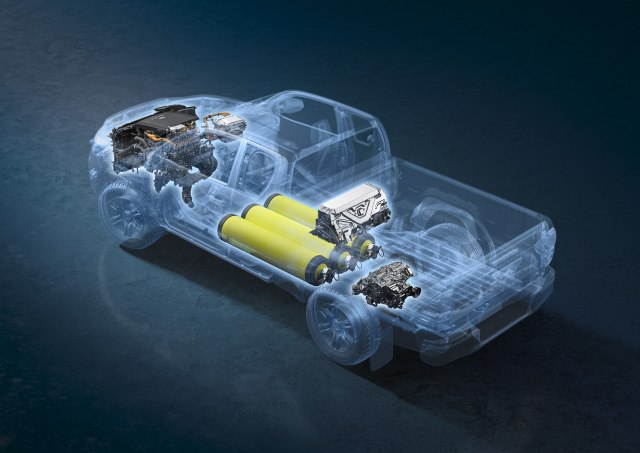
TMUK will lead this project, while a team within Toyota Motor Europe (TME) R&D will provide expertise and technical support, to enable other teams in the UK to build their own technology and become ready to develop the next generation of hydrogen propulsion.
For more than 20 years, Toyota has promoted a comprehensive approach to carbon neutrality by offering a diverse range of vehicles, including all electrified technologies, hybrid-electric, plug-in hybrid-electric, as well as battery electric and fuel cell electric cars.
The successful development of the hydrogen-powered transport sector is an essential element for reaching this goal. As part of the offer, the first prototype vehicle will be produced at TMUK's facilities in Burnston during 2023. After achieving successful results, the goal is to prepare for small series production. This project represents an exciting opportunity to explore the possibilities of further applications of Toyota's fuel cell technology in the vehicle segment, which is key to a number of industries, and which will help support the sector's move towards decarbonisation.
"Great Britain is one of the key markets for pick-up vehicles, but it is also an important market for Toyota. This investment represents a huge opportunity to develop solutions for zero emission vehicles in a very important segment of the market. We would like to thank the UK Government for the financial investment that will enable the consortium to explore further development of fuel cell powertrains for the Toyota Hilux model, supporting our plans to achieve carbon neutrality”.

















